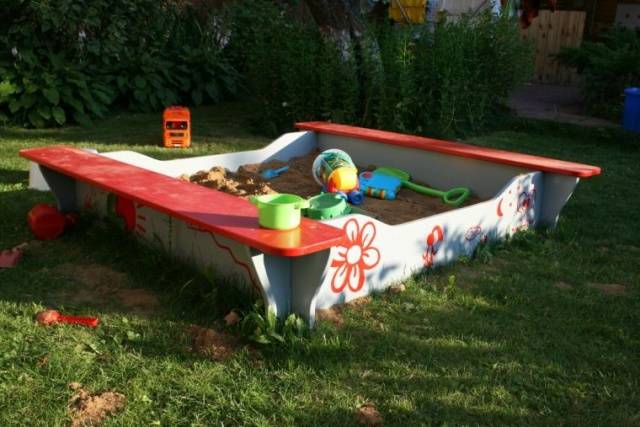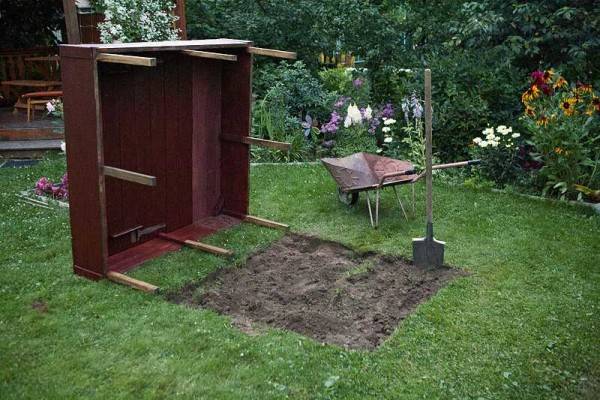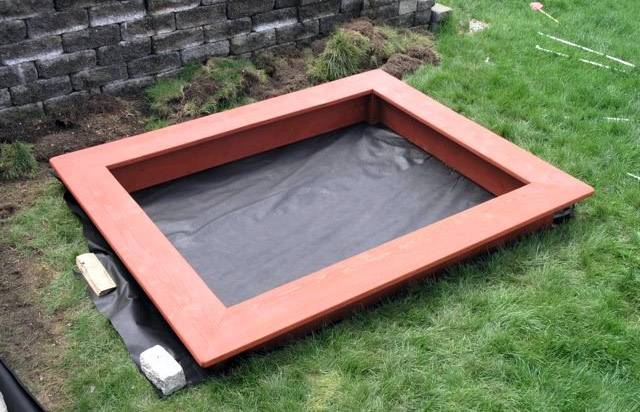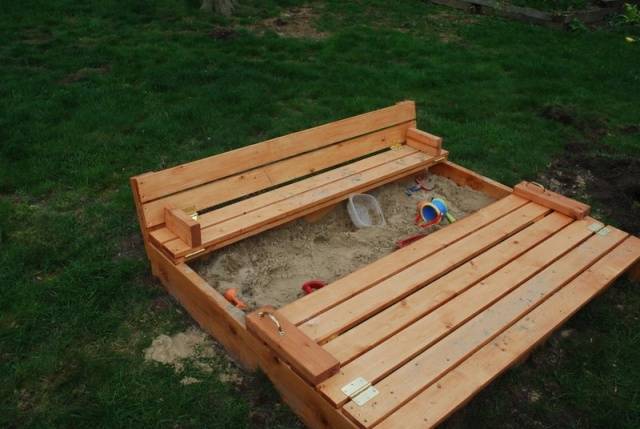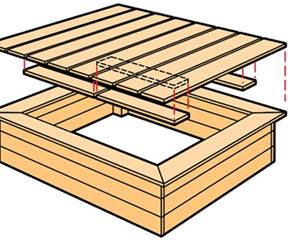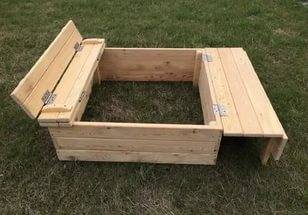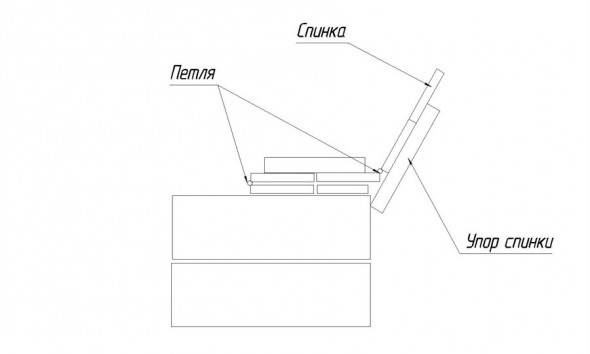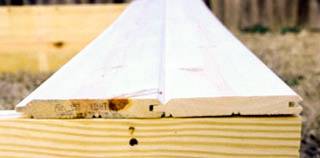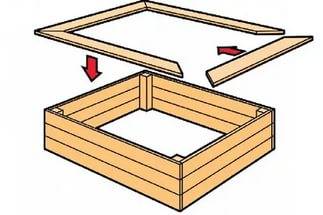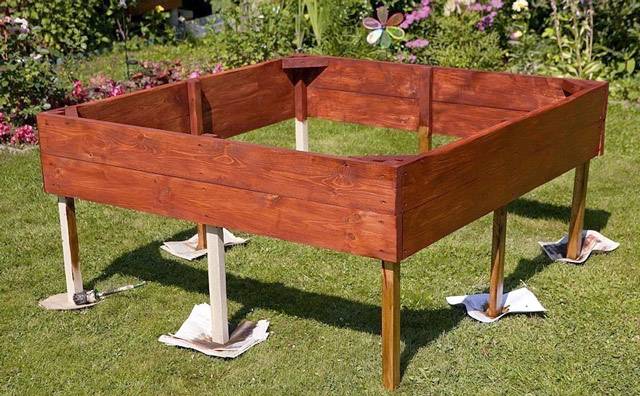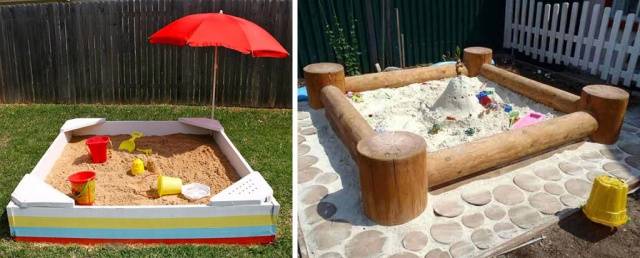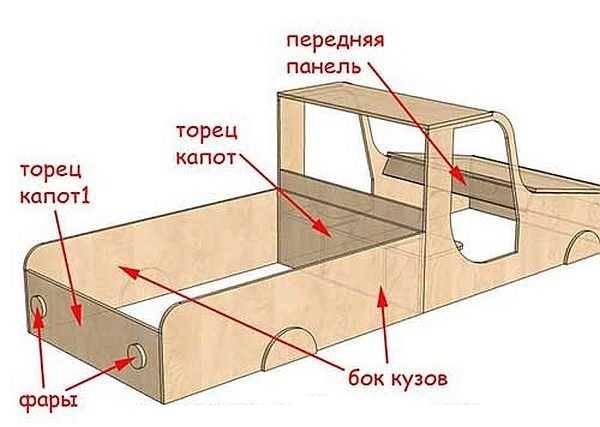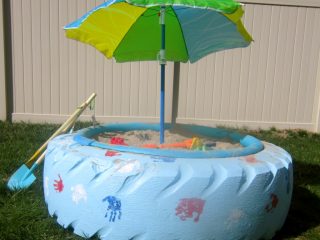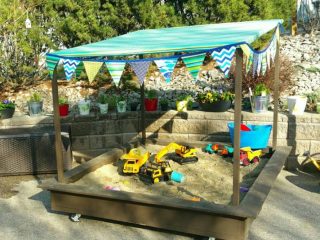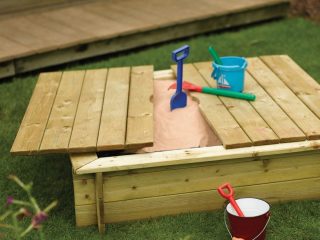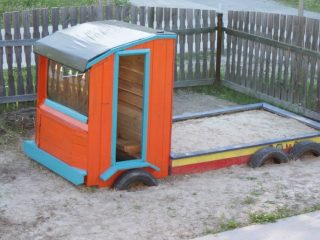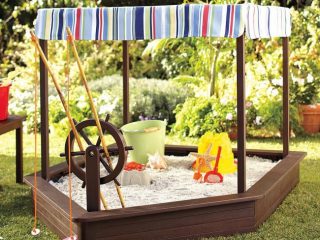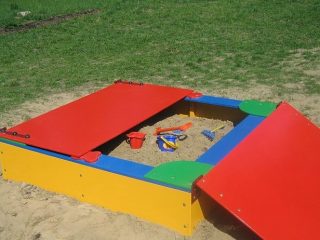Content
- 1 Choosing the optimal place for a wooden sandbox
- 2 Solving the issue of making a lid
- 3 Preparing material for a wooden sandbox
- 4 The procedure for making a box
- 5 Side edging
- 6 Installing the box in its permanent place
- 7 Filling a wooden sandbox with sand
- 8 Option for an interesting children's sandbox made of wood
A sandbox is not only a place for a child to play. Modeling Easter cakes and building castles develops a child's thinking and hand motor skills. Modern parents are accustomed to buying plastic sandboxes in the store. However, such toys are very expensive and not everyone can afford them. In private courtyards, children's sandboxes made of wood are most often installed, which will not be difficult to make yourself.
Choosing the optimal place for a wooden sandbox
A wooden sandbox made in the yard should not be hidden far behind buildings. It is better to equip a place for children to play in a visible place. It is advisable to abandon the northern side of the yard, otherwise the sand will be constantly wet and cold. It’s bad if the sandbox is illuminated by the sun all day. The child will not be able to play in extreme heat. But you can’t completely hide the playing area in the shadows. The sand here won't warm up well.
It is optimal to install a wooden sandbox for children in a semi-sunny place. The spreading crown of a large tree will be an ideal shelter from the heat.However, some problems may arise here too. It is impossible to place a children's sandbox under old and fragile trees due to the threat of thick branches falling. Harmful insects and rotten fruits will constantly fall from fruit plantings into the sand.
We prepare a place for installing a wooden box and arrange the bottom of the sandbox
According to the principle of use, children's wooden sandboxes are seasonal and all-season. The first structure can be built without a bottom. It is enough to install a small wooden box for the summer period, and put it under a canopy in winter. All-season sandboxes for children are installed on an ongoing basis. They remain to spend the winter, and so that the sand does not turn into mud over time, it is separated by the bottom from the main soil.
By their design, seasonal and all-season wooden sandboxes are a regular box, most often with a lid. They are installed and manufactured in the same way. The only difference may be the bottom design.
Let's look at the photo of how they prepare a place for a wooden box and arrange the bottom:
- Initially, drawings of a wooden sandbox are developed in order to know its dimensions. According to the dimensions of the box, markings are carried out on the site. This is easier to do with wooden stakes and construction cord. Using a bayonet shovel, according to the applied markings, remove the turf layer of soil to a depth of 20 cm.For an all-season wooden sandbox, you can make a gravel backfill on the sides of the box to drain water after rain or melting snow. To do this, the sides of the pit are expanded by 30–50 cm.
- The bottom of the dug hole is leveled with a rake and then lightly compacted. For an all-season wooden sandbox you will need to make drainage. The bottom of the pit is covered with a layer of clean sand or mixed with gravel 10 cm thick. If this is a seasonal option, then the bottom of the pit can simply be compacted.
- So, we decided that for any wooden sandbox it is better to make a bottom. To do this, take geotextiles and lay them out along the bottom of the pit. You can use dense agrofibre or cut old polypropylene bags. When in the future the wooden box is installed in its permanent place, the bottom material should extend beyond the boundaries of the sides.
- After installing the all-season sandbox box, the material is tucked in, then stapled to the sides, and the excess is cut off. There is no point in fixing the bottom of a seasonal wooden sandbox. The material is simply rolled up to the sides and pressed down with soil.
This is the principle used to prepare the place where a wooden sandbox for children will be installed.
Solving the issue of making a lid
Even if parents have overcome their laziness to make a sandbox with their own hands for their child, there is less and less desire to make a lid. Is it necessary? Judge for yourself. Sand is a favorite place for yard animals to organize a toilet. During the wind, dry sand will be blown out and various debris will be deposited into the box. You don’t want your child to rummage in such sand later, do you? So, a lid is needed.
You can use a piece of film as a lid, but you will have to constantly press it down with bricks or pieces of wood at night. In order not to have to deal with this procedure every day, it is better to take another half a day and make a normal lid for the wooden sandbox.
The simplest model of a lid
First, let's look at how to make a wooden lid without much effort. Its design is an ordinary shield, made of boards 15–20 mm thick. The lid is covered with linoleum or film on top to prevent rainwater from penetrating through the cracks into the sand. Handles are attached on both sides for easy removal of the shield.
The disadvantage of this design is that the lid cannot be opened independently by children. Even thin boards will make a massive shield. The child may try to pull it to the side by the handle, but there is a risk of injury.
Folding lid model
If you are making a wooden sandbox with a lid, then it is better to pay attention to the folding model. A photo of a diagram of this design clearly shows how an ordinary shield turns into a comfortable bench.
If the boards are connected with a rubber band, then such a shield can be rolled up. The lid of two halves is attached with hinges to opposite wooden sides, and if necessary, the segments are opened to the side.
If you want a children’s sandbox made of wood with your own hands to bring real joy to your child, equip it with a folding lid and a bench. To make it, you only need eight loops that connect the individual elements. The lid consists of two halves, each of which contains three boards.One of them is permanently attached to the side of the wooden sandbox, and the other two are connected with hinges. Outside and inside, limiters made of bars are installed, which serve as a support for the backrest.
Preparing material for a wooden sandbox
If you still decide to build a sandbox with your own hands from wood, you must immediately prepare good edged boards. Obapols, old rotten blanks and other rubbish are not suitable for the box. A child can get hurt on such a sandbox and pick up splinters. The boards are taken new, preferably from pine. Poplar is short-lived, and oak, larch and other hardwoods are difficult to process. A tongue and groove board is ideal. A tight connection of the grooves will prevent sand from spilling into the cracks, as well as the penetration of rainwater.
All wooden pieces are sanded. The surface is made smooth, without a single burr. To make the wood last longer, it is impregnated with an antiseptic. You cannot use waste oil, or even clean machine oils. The structure will acquire an unpleasant odor, and in addition, the child will constantly dirty his clothes.
When the box is already made, it needs to be painted. It is advisable to choose multi-colored oil or acrylic paints. A child will like a bright sandbox and will have an attractive appearance.
The procedure for making a box
So, all the materials are prepared, and it’s time to build a wooden sandbox with your own hands, covered with a lid. You can make a box according to the proposed scheme. The sides are assembled from two or three boards so that their height is within 40 cm. The optimal size of a wooden box is 1.5 x 1.5 m, but the board is taken 1.8 m long. 15 cm are removed from each side of the workpiece, and grooves are cut out with a hacksaw .When all the boards are prepared, they are connected groove to groove, as shown in the diagram. To ensure the reliability of the units, use a bolted connection or self-tapping screws.
Legs made of timber with a cross section of 50x50 mm are nailed to the finished wooden box in the corners and center of the sides. The supports protrude down the box and are needed to fix the sandbox in the ground.
Side edging
An assembled wooden sandbox in the shape of a square box is not considered a completed structure. It's time to remember the lid. It’s too early to fix it, but further refinement of the wooden box depends on the chosen design. If the choice fell on a folding lid, then the ends of the sides only need to be sanded, and nothing else is done to them. After installing the lid on the sides of the box, most of the ends will disappear under the bench.
When making a removable cover from a shield, the child does not have the opportunity to sit. Edging the sides with a board laid flat will help you make a simple bench. In addition, this design will hide the inconvenient thin ends of the box, which a child can hit. Benches are made from four boards, the edges of which are sawn off at an angle of 45O. The bench mounting diagram is shown in the photo.
Installing the box in its permanent place
After completing the box manufacturing work, you should end up with a box with eight legs, as in this photo. The place for its installation has already been prepared, but not quite. You will have to perform a few more steps:
- A knocked down wooden box with legs is placed on a prepared platform. Moreover, the bedding material from the bottom of the pit must be temporarily removed. Around the legs, places for grooves are marked on the ground.
- The box is removed to the side where it is treated with an antiseptic. Wooden legs are covered with bitumen mastic.This way, the wood will stay in the ground longer. While the structure dries out, grooves are dug in the marked area.
- The depth of each groove should correspond to the length of the leg, taking into account the fact that the backfill is made of sand with crushed stone 10 cm thick. To dig grooves, it is better to use a garden drill with a diameter of 80–100 mm.
- Now it's time to lay the lining material in place. The piece is larger than a wooden sandbox, so it will cover all the holes. In these places, neat holes are cut under the legs, after which the box is installed. The edges of the material are folded to the sides, where it is secured or pressed down with soil.
- A dug trench 40–50 cm wide remains around the box. Its bottom should be covered with black agrofibre, and a layer of sand and gravel should be poured on top. Thanks to the resulting backfill, water will not accumulate around the sandbox, and the agrofibre will not allow weeds to grow.
With this, the base of the wooden sandbox is installed. All that remains is to secure the folding lid-bench, and you can start painting the product.
Filling a wooden sandbox with sand
So, the paint has dried, it’s time to fill the box with sand and invite the child to the playground. The choice of filler must be taken seriously. For sandboxes, river or quarry sand is used, but not all of it is ideal. Too fine white sand practically does not mold, and when it dries out it becomes very dusty. In windy weather, the baby will not be able to play, as his eyes will become clogged. Gray quartz filler will not work. There is little dust from it, but it also does not stick, and besides, it severely scratches the delicate skin of the child’s hands. There is also orange-colored gully sand.It has many admixtures of clay, which contributes to good modeling, but it heavily stains hands and clothes. A suitable filler is white sand with a yellowish tint, preferably of medium grain size.
The video shows a version of a children's sandbox:
Option for an interesting children's sandbox made of wood
A square wooden sandbox is a classic option. If you want to surprise your child and make him a real playground, the issue will have to be solved in a creative way. The photo shows a diagram of a sandbox in the form of a car. This is ideal for a boy. In addition to playing in the sand, the baby will travel, repair a car, or come up with a lot of other things.
This entertainment can be made from moisture-resistant plywood or OSB. Fragments of the car are cut out of the sheets, after which they are connected according to the proposed scheme. The finished structure is painted as realistically as possible so that it resembles a real truck.
There are many ideas for making wooden sandboxes. Wood is very malleable to processing, and allows you to create real miracles.
